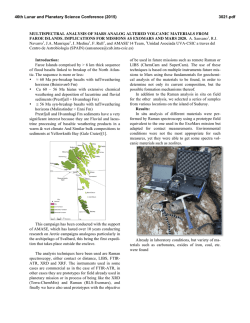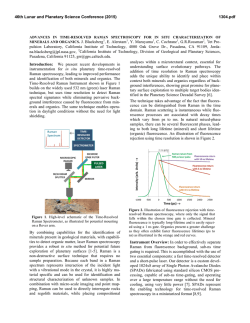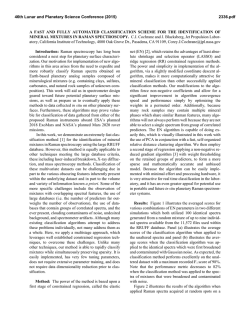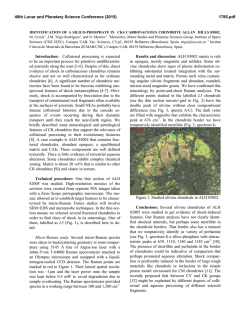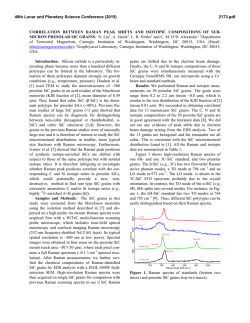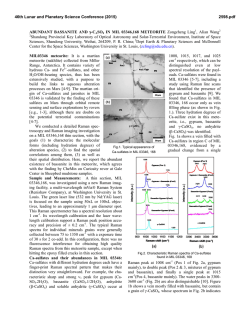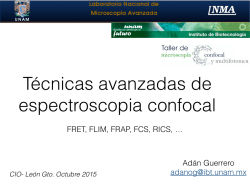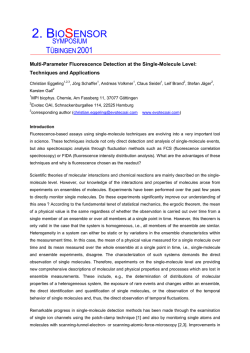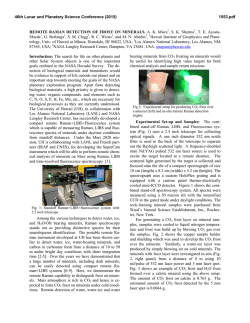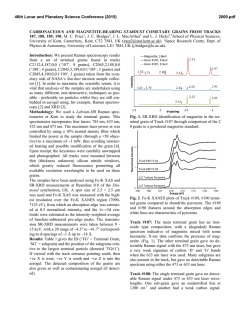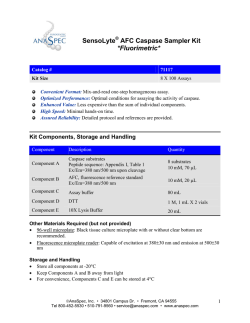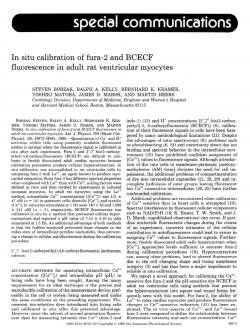
Standoff Time-Resolved Fast Fluorescence of Organics and Amino
46th Lunar and Planetary Science Conference (2015) 2613.pdf Standoff Time-Resolved Fast Fluorescence of Organics and Amino Acids. G. Berlanga, T. E. Acosta-Maeda, A. K. Misra, S. K. Sharma, L. P. Flynn, Hawaii Institute of Geophysics and Planetology, Univ. of Hawaii at Mānoa, Honolulu, HI 96822, USA. [email protected] Introduction: Detection and characterization of organics, proteins, and amino acids play a significant role for NASA’s search for past and present life in astrobiological targets. Amino acids and nucleobases are of particular interest due to their involvement in biological processes and as basic constituents of life as we know it. Proteinogenic and non-proteinogenic amino acids and nucleo bases have been reported in Martian meteorites, carbonaceous chondrites, and in samples returned by NASA’s Stardust spacecraft from comet 81 P/Wild 2 [1-4]. Characterization of key proteins and amino acid signatures such as tryptophan, tyrosine, phenylalanine, glycine, β-alanine, γ-amino-nbutyric acid, L-alanine, L-Glutamic acid, and βaminoisobutyric acid supports future rover investigations on astrobiological targets. Fluorescence excitation of individual aromatic residues of folded proteins, such as tryptophan, tyrosine, and phenylalanine, will aid in identifying amino acid interactions that lead to active protein native states [5]. In the Mars 2020 mission, the SuperCam instrument will be able to remotely analyze targets using Raman spectroscopy, Laser-Induced Breakdown Spectroscopy (LIBS), and Time-Resolved Fluorescence Spectroscopy (TRFS), without the need for sample manipulation or treatment. Among the three techniques, the Raman spectroscopy provides unambiguous identification of organics, inorganics and biological components [6]. Both LIBS and fluorescence spectroscopies have much higher sensitivity for detecting very low concentration of biological component. Raman and fluorescence spectroscopies provide nondestructive detection of bio-molecules in comparison to LIBS. Laser-induced fluorescence (LIF) spectroscopy is based on measuring the optical emission of molecules that have been excited to higher energy levels by absorption of electromagnetic radiation from a monochromatic pulsed laser source. Fluorescence signals are several orders of magnitude higher than Raman signals, which make the LIF technique suitable for detecting a minute amount of bio-molecules in a large search area. Planetary minerals containing transition metal and rare-earth ions produce fluorescence spectra when excited with UV and visible lasers. This fluorescence can in some cases overlap with the fluorescence spectra of biogenic and organic compounds. However, the fluorescence decay time or lifetime of biogenic and organic compounds is much shorter (<100 ns) as compared to the fluorescence decay time of µs to ms of the transition metal ions and rare-earth ions in minerals and rocks. This feature is exploited in the time resolved fluorescence spectroscopy to detect a biological target. Here, we present data on various amino acids, proteins, and hydrocarbons using remote time-resolved fluorescence spectroscopy. Instrumentation: For this study a combined remote Raman+LIBS+TRFS system utilizing a 532 nm Nd:YAG pulsed laser and an 8 inch collection telescope was used. Remote TRFS spectra were measured in the 350-850 nm spectral range from a distance of 9 m using 10 mJ/pulse of laser power for excitation. For planetary exploration, a compact, portable remote Raman+LIBS+TRFS system using 2.5 inch telescope has also been developed under the Mars Instrument Development Program [4, 7]. The prototype is capable of measuring mineral targets up to 50 meters away using Raman and fluorescence spectroscopies and has a LIBS range of 10 m. The laser spot diameter is adjustable between 0.3 mm and several cm. Good quality spectra can be obtained at shorter distances of 10 m or less within 1 s integration times. The system includes time gating capabilities therefore is able to distinguish between organic and inorganic fluorescence, as well as identify atmospheric gases between the system and target. Samples and Methodology: We measured all of the proteinogenic amino acids (21 L-amino acids and glycine kit, Fluka), sarcosine, and several polyaromatic hydrocarbons, such as anthracene. Samples were placed and measured through sealed glass vials. The lower Raman cross-section of glass allowed for sample analysis without interference from the glass sample holder [8]. Remote fluorescence measurements were recorded from 9 m distance with 1 s detection time (equal to 15 laser shots excitation) using a 10 mJ/pulse laser power output, and 7 mm laser spot size on the target. The time-resolved fluorescence spectra were measured with sequential 10 ns gate widths. Results and Discussion: Time resolved fast fluorescence measurements were made on 31 amino acids, proteins, and hydrocarbons. Exponential decay was witnessed in all fluorescent molecules with a duration of less than 100 ns (fast fluorescence). The rate of this decay is sensitive to environmental variables that quench the fluorescence. Strong fluorescence signals with very short lifetimes were observed in most amino 46th Lunar and Planetary Science Conference (2015) acids. In addition, sharp peaks corresponding to spontaneous Raman signals were observed concurrently. Figures 1 and 2 show time-resolved fluorescence spectra of L-Tryptophan and L-Phenylalanine respectively, over sequential 10 ns time intervals with a 1 s integration time. The inelastic Raman scattering caused by the vibrational modes of molecules has a life-time of ~1013 s resulting in Raman signals that are simultaneously observed along with the bio-fluorescence signal in nanosecond time frames. Figure 1: L-Tryptophan exhibits a wide fluorescence band at ~620 nm. Aromatic amino acid fluorescence arises from free electrons inside the aromatic rings. Acosta-Maeda et al., [4] show complementary Raman spectra to the fluorescence spectra presented here. Figure 2: L-Phenylalanine exhibits a wide fluorescence band at ~615 nm and several Raman peaks with strongest Raman line at 635.8 nm. It is an aromatic amino acid and exhibits Raman lines representative of CH rings arising from ring-breathing vibrations in the mono-substituted aromatic compounds and from aromatic C-H stretch vibrations. Figure 3 shows the relative intensity of fast fluorescence of various proteins and amino acids under the 2613.pdf same experimental conditions. Acenapthene Benzene exhibited the strongest fluorescence completely masking the Raman lines. Fluorene, L-Tryptophan, Fluoranthene, and L-Serine exhibited the next highest fluorescence signals, with Fluorene showing strong Raman lines at 582.2 nm and 635.3 nm. Urea displayed the lowest fluorescence signal. Conclusions: Characterization of amino acids, proteins, and other organic material provides the necessary biomarker signatures to successfully distinguish between fluorescent inorganics and biogenic materials on planetary surfaces. Daytime detection of amino acids and nucleo basis from a distance of 9 m has been demonstrated using time-resolved fluorescence spectroscopy that is well suited for planetary exploration applications, requires no sample preparation or collection, and provides non-destructive rapid detection. Future work on the expansion of the combined Raman fluorescence spectral range into UV and IR will provide the necessary signatures to fully identify the amino acids and proteins. Acknowledgements: This work has been supported by NASA EPSCoR grant NNX13AM98A. References: [1] Burton A. S. et al. (2013) LPSC XLIV, Abstract #2613. JGR, 90, 1151–1154. [2] Callahan M. P. et al. (2011) . PNAS 108,13995– 13998.. [3] Elsila J. E. et al. (2009) Meteoritics & Planet. Sci., 44, 1323-1330. [4] Acosta-Maeda T. E. et al (2014) LPSC XLV, Abstract #2331. [5] Berg et al. (2002). Biochemistry. “Protein Structure and Function.”, Ch. 3, W. H. Freeman, NY. [6] Villar & Edwards (2006) Anal. Biochem. 384, 100–113 [7] Misra et al. LPSC XLV, Abstract #1498. [8] McCreery R. L. “Photometric Stds. For Raman Spec.”, Handbook of Vibrational Spectroscopy, John Wiley and Sons.
© Copyright 2026
